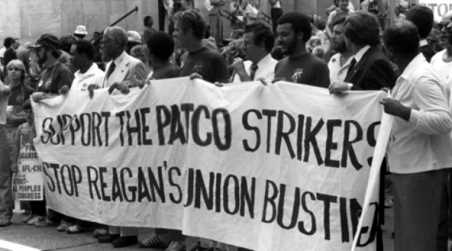
On this date in 1981, following the Professional Air Traffic Controllers Organization (PATCO) workers’ refusal to return to work, President Ronald Reagan fired the 11,345 strikers and banned them from federal service for life.
PATCO operated from 1968 until its decertification in 1981 following this strike. The defeat of PATCO was called “one of the most important events in late twentieth century U.S. labor history” by labor historian Joseph A. McCartin.
PATCO was founded in 1968 with the assistance of attorney and pilot F. Lee Bailey. In its first action, in July 1968, PATCO announced “Operation Air Safety,” in which all members were ordered to adhere strictly to established aircraft standards. The resultant mass delay of air traffic was the first of many official and unofficial “slowdowns” that PATCO would initiate.
In 1969, the U.S. Civil Service Commission ruled that PATCO was no longer a professional association but in fact a trade union. In organized “sick-outs” the union protested many Federal Aviation Authority (FAA) actions that they felt were unfair. Controllers called in sick to circumvent the federal law against strikes by government unions. Management personnel attempted to assume many of the duties of the missing controllers but major traffic delays around the country occurred. After a few days, federal courts intervened and most controllers went back to work, but the government was forced to the bargaining table.
The actions led officials to recognize weak points in air traffic control. Congress accelerated the installation of automated systems, reopened the air traffic controller training academy in Oklahoma City, began hiring air traffic controllers at an increasing rate, and raised salaries to help attract and retain controllers.
Elections have consequences
In the 1980 presidential election, PATCO (along with the Teamsters and the Air Line Pilots Association) refused to back incumbent President Jimmy Carter, instead endorsing the Republican Ronald Reagan. PATCO’s alienation from the Democrats stemmed in large part from poor labor relations with the FAA (the employer of PATCO members) during the Carter years.
Reagan’s embraced the union and its struggle for better conditions during the election campaign. He saw in PATCO a group of compatible unionists. Most of them had served in the military and were social conservatives. After the election, PATCO expected a return from its endorsement, but when the union declared a strike on Aug. 3, 1981, seeking better working conditions, better pay and a 32-hour workweek, Reagan would not go along. During a press conference that day regarding the PATCO strike, President Reagan stated: “They are in violation of the law and if they do not report for work within 48 hours they have forfeited their jobs and will be terminated.” Only 1,300 of the nearly 13,000 controllers returned to work.
PATCO declared that it no longer wanted to be included within the civil service clauses that had haunted it for decades, thus violating the law that banned strikes by government unions, but which had rarely been enforced. Ronald Reagan declared the PATCO strike a “peril to national safety” and ordered the controllers back to work under the terms of the Taft-Hartley Act of 1947.
PATCO was decertified from its right to represent workers by the Federal Labor Relations Authority on October 22, 1981, and heavy fines forced it into bankruptcy. In the wake of the strike and mass firings, the FAA took close to ten years before the overall staffing levels returned to normal.
The civil service ban on the remaining strike participants was lifted by President Bill Clinton in 1993, but only about 800 returned to work. Many of the others had been reduced to poverty, blacklisted from federal employment.
Georgetown University professor Joseph McCartin’s 2011 book, “Collision Course: Ronald Reagan, The Air Traffic Controllers, and the Strike that Changed America,” argues that Reagan’s unilateral decision to fire the controllers scared other workers, too. “To see highly skilled workers like these banned” from getting their jobs back “and permanently replaced changed things in this country,” McCartin has said. “Private employers applauded and followed” Reagan’s example “time after time.”
The strike and its aftermath have set the tone for over 30 years. “The attack on collective action and the ability to strike has been devastating,” says McCartin. “After 1981, Reagan and his followers willingly donned the mantle of union-busters. And he made union-busting a litmus test for conservatives,” such as we see across the country today.
Adapted from Wikipedia and People‘s World.










